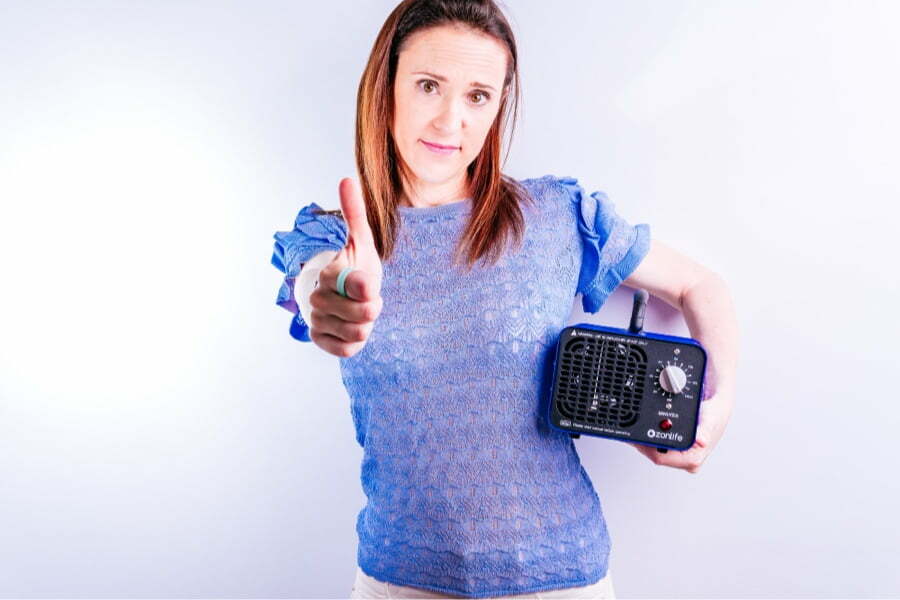In this blog post, I will explore the advantages and disadvantages of using ozone generators for air purification.
As I sat in my living room, surrounded by the comforting hum of my air purifier, I couldn’t help but wonder about the other options out there for improving indoor air quality. That’s when I stumbled upon ozone generators – a device that claims to eliminate odors and pollutants from the air using ozone molecules.
Intrigued by this new discovery, I decided to dive deeper into the world of ozone generators and explore their pros and cons. Join me on this journey as we uncover whether these devices are worth incorporating into our homes or if they’re just a bunch of hot air.
Key takeaways:
- Ozone generators can eliminate strong odors from indoor spaces.
- Ozone generators claim to remove pollutants like mold spores and bacteria.
- High levels of ozone can be harmful to humans and pets.
- Alternatives to ozone generators include HEPA filters and indoor plants.
- Ozone generators have specific guidelines and restrictions for usage.
The Ozone Generator Story

The story of ozone generators dates back to the late 1800s when scientists first discovered the existence of ozone. It wasn’t until much later that people began using it for air purification purposes.
In recent years, however, these devices have gained popularity as a way to eliminate odors and pollutants from indoor spaces.
But with any new technology comes controversy and debate. Some experts argue that ozone generators are effective at removing harmful particles from the air while others claim they can be dangerous if not used properly.
As I delved deeper into my research on these devices, I found myself torn between their potential benefits and risks. On one hand, they offer a chemical-free solution for improving indoor air quality without relying on filters or other consumables.
On the other hand, excessive exposure to high levels of ozone can cause respiratory problems and even damage lung tissue.
So what’s the verdict? Are ozone generators worth investing in or should we stick with more traditional methods like HEPA filters? Let’s take a closer look at some pros and cons so you can make an informed decision for yourself.
Understanding Ozone Purification
Before we dive into the pros and cons of ozone generators, it’s important to understand how they work. Ozone is a gas made up of three oxygen atoms (O3) that can be produced through various methods, including lightning strikes and UV radiation.
When introduced into the air, ozone molecules attach themselves to pollutants such as bacteria, viruses, mold spores and odors – effectively neutralizing them.
However, while this may sound like a miracle solution for indoor air quality issues – there are some potential drawbacks to consider before investing in an ozone generator.
As I delved deeper into my research on these devices after discovering them during my living room pondering session mentioned earlier; I found myself torn between their benefits and risks. On one hand- they offer an effective way to eliminate harmful pollutants from our homes without using harsh chemicals or filters that need constant replacement.
But on the other hand- there are concerns about their safety when used improperly or excessively.
So let’s take a closer look at both sides of this debate by examining some key pros and cons associated with using ozone generators for air purification purposes:
Pros: Breathe Easier With Ozone

One of the most significant advantages is their ability to eliminate strong odors from indoor spaces.
As someone who loves cooking with garlic and onions, this was music to my ears! Ozone molecules are highly reactive and can break down odor-causing compounds in the air, leaving your home smelling fresh and clean.
But that’s not all – ozone generators also claim to be effective at removing pollutants such as mold spores, bacteria, and viruses from the air we breathe. This is especially important for those with allergies or respiratory issues who may be more sensitive to these types of irritants.
Using an ozone generator can help improve indoor air quality by reducing unpleasant smells and harmful pollutants in our homes. However, before rushing out to buy one for yourself there are a few cons you should consider as well…
Cons: Hidden Dangers of Ozone Generators

One major concern is the hidden dangers associated with these devices. While ozone molecules can effectively eliminate odors and pollutants from the air, they can also be harmful to humans and pets when inhaled in large quantities.
In fact, according to a study conducted by the California Air Resources Board (CARB), prolonged exposure to high levels of ozone can cause respiratory issues such as coughing, chest pain, shortness of breath and even lung damage. This is particularly concerning for those who suffer from asthma or other respiratory conditions.
Furthermore, some studies have shown that long-term exposure to low levels of ozone may increase one’s risk for developing certain types of cancer. It’s important to note that while most manufacturers claim their products are safe when used properly – it’s always better safe than sorry!
Alternatives to Air Purification

One popular alternative is using HEPA filters in your home’s HVAC system or purchasing standalone HEPA air purifiers. These devices use high-efficiency particulate air (HEPA) filters to trap particles as small as 0.3 microns – including dust, pollen, and pet dander – from circulating in your home’s air.
Another option is investing in plants that naturally purify the surrounding environment by absorbing toxins and releasing oxygen back into the atmosphere. Some examples include spider plants, peace lilies and snake plants.
While these alternatives may not be as effective at eliminating odors or chemical pollutants like an ozone generator claims to do so quickly; they offer a more natural approach for those who prefer avoiding synthetic chemicals altogether while still achieving cleaner indoor environments with fewer allergens present than before!
In-depth: How Ozone Generators Work
Ozone generators are air purification devices that work by producing ozone, a highly reactive gas composed of three oxygen atoms. These generators use either corona discharge or ultraviolet light to create ozone molecules from the surrounding air.
Once generated, the ozone is released into the environment where it reacts with pollutants and odors.
Corona discharge ozone generators utilize an electrical charge to split oxygen molecules (O2) into individual oxygen atoms. These free atoms then combine with other O2 molecules in the air to form O3, or ozone.
The resulting high concentration of ozone is dispersed throughout the room or area being treated.
On the other hand, ultraviolet light-based systems pass ambient air over a UV lamp that emits short wavelength radiation capable of breaking apart O2 molecules and creating single oxygen atoms. Similar to corona discharge models, these free radicals then react with additional O2 particles in order to produce higher levels of atmospheric ozone.
It’s important to note that while both types generate significant amounts of this powerful oxidizing agent for effective purification purposes, they differ slightly in terms of efficiency and output levels.
Understanding the Ozone: ‘Good’ and ‘Bad’ Explained
In the upper atmosphere, ozone plays a crucial role in protecting us from harmful ultraviolet radiation. However, when ozone is present at ground level, it can have detrimental effects on human health.
At ground level, ozone is considered a pollutant and can contribute to poor air quality. It forms through chemical reactions between nitrogen oxides (NOx) and volatile organic compounds (VOCs), which are emitted by various sources such as vehicles, industrial processes, and certain household products.
Exposure to high levels of ground-level ozone can lead to respiratory issues such as coughing, throat irritation, chest pain or tightness, shortness of breath,and worsened asthma symptoms. Prolonged exposure may also cause lung inflammation and damage over time.
On the other hand,ozone generators intentionally produce high levels of ozone for air purification purposes.Ozone has strong oxidizing properties that allow it to react with pollutants like bacteria,viruses,mold spores,and odors.These generators work by releasing controlled amounts of O3 into indoor spaces where they chemically react with airborne contaminants,resulting in their elimination or neutralization.However,it’s important to note that while these devices effectively remove pollutants,the elevated levels of generated O3 may pose risks if not used properly.It’s essentialto follow manufacturer instructions carefullyand ensure adequate ventilation during operation,to minimize potential health hazards associated with excessive exposure.
Genetic Impact of Prolonged Ozone Exposure
Ozone is a highly reactive gas that can penetrate deep into the respiratory system and cause oxidative stress in cells. This oxidative stress can lead to DNA damage, mutations, and alterations in gene expression.
Studies have shown that long-term exposure to high levels of ozone is associated with an increased risk of respiratory diseases such as asthma, chronic obstructive pulmonary disease (COPD), and lung cancer. Research has indicated that prolonged ozone exposure may also contribute to cardiovascular problems and neurological disorders.
Furthermore, it has been found that prenatal exposure to elevated levels of ozone may result in adverse effects on fetal development. Studies suggest a potential link between maternal ozone exposure during pregnancy and an increased risk of preterm birth, low birth weight babies, developmental delays, and even genetic abnormalities.
It is important for individuals who are considering using ozone generators for air purification purposes or living in areas with high ambient levels of outdoor pollution containing ground-level ozone should be aware of these potential genetic impacts.
Regulations Surrounding the Use of Ozone Generators
In many countries, including the United States and Canada, there are specific guidelines and restrictions regarding ozone generator usage.
The Environmental Protection Agency (EPA) in the United States has set a limit on indoor ozone levels to protect public health. According to their guidelines, indoor ozone concentrations should not exceed 0.08 parts per million (ppm) over an eight-hour period.
Some states have implemented stricter regulations on ozone generator usage due to concerns about potential health risks associated with high levels of exposure. It is crucial for individuals interested in using these devices to familiarize themselves with local laws and regulations before making a purchase or operating an ozone generator.
Comparing Ozone Generators With Other Air Purification Technologies
It’s important to consider how they compare with other technologies before making a decision.
One popular alternative is HEPA (High-Efficiency Particulate Air) filters. These filters work by trapping particles like dust, pollen, and pet dander in a fine mesh.
Unlike ozone generators, HEPA filters do not produce any harmful byproducts and are highly effective at removing airborne allergens.
Another option is activated carbon filters which excel at eliminating odors and volatile organic compounds (VOCs). They work by adsorbing these substances onto their porous surface.
While they may not be as effective as ozone generators for killing bacteria or mold spores, activated carbon filters provide excellent odor control without producing any harmful chemicals.
UV-C germicidal lamps are also commonly used for air purification purposes. These lamps emit ultraviolet light that can kill bacteria and viruses in the air when exposed to them directly.
However, UV-C lamps have limited effectiveness against larger particles like dust or pet dander compared to both ozone generators and HEPA filters.
It’s worth noting that each technology has its own strengths and weaknesses depending on your specific needs regarding indoor air quality improvement.
FAQ
What are the negative effects of ozone generator?
The negative effects of ozone generators include harm to lung cells and respiratory airways, resulting in symptoms like inflammation, coughing, chest tightness, shortness of breath, and impaired breathing.
What is better air purifier or ozone generator?
Air purifiers are typically a better choice as they filter the air without releasing pollutants, unlike ozone generators which release a gas that is considered a pollutant.
What happens if you stay in a room with an ozone generator?
Staying in a room with an ozone generator can lead to adverse health effects such as chest pain, coughing, shortness of breath, throat irritation, worsening of chronic respiratory diseases like asthma, and a weakened ability to fight respiratory infections.
Why is ozone bad for the air?
Ozone is harmful for the air as it can damage the respiratory tract and cause various health issues, in addition to causing substantial harm to the environment including crops, forests, and native plants.
How does the operation of an ozone generator impact individuals with respiratory conditions?
Ozone generators, which intentionally produce the gas ozone, can exacerbate respiratory conditions like asthma by reducing lung function and inflaming the lungs' lining.
Is it safe to use an ozone generator around pets and plants?
No, using an ozone generator around pets and plants is not considered safe as it can potentially harm or kill them.
Can the usage of ozone generators worsen existing indoor air pollution problems?
Yes, the application of ozone generators can exacerbate existing indoor air pollution issues by reacting with certain volatile organic compounds and forming harmful byproducts.